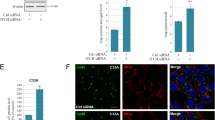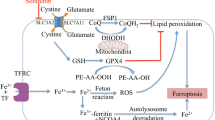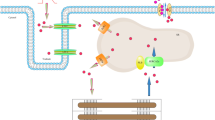Abstract
We hypothesized that Ca2+ entry through the window T-type Ca2+ current causes apoptosis. To test this hypothesis, we transfected human embryonic kidney (HEK) 293 cells to express recombinant Cav3.2 T-type Ca2+ channels (hereafter called HEK-Cav3.2 cells). After incubation in media containing a high concentration (7.2 mM) of Ca2+, intracellular Ca2+ levels increased in HEK-Cav3.2 cells without electrical stimulation but not in untransfected HEK293 cells. In quiescent HEK-Cav3.2 cells exposed to high Ca2+ media, apoptosis, as indicated by the appearance of hypodiploid cells, loss of mitochondrial transmembrane potential, and activation of caspases-3 and -9 was observed, while caspase-8 was not activated. These apoptosis-associated changes were blunted by pretreatment with the R(−)-isomer of efonidipine, a selective blocker of T-type Ca2+ channels. High Ca2+ did not induce apoptosis in untransfected HEK293 cells. Our findings show that Ca2+ entry through the steady-state window current of T-type Ca2+ channels causes apoptosis via mitochondrial pathways, and suggests that T-type Ca2+ channels may be novel therapeutic targets for several diseases associated with abnormal apoptosis.




Similar content being viewed by others
References
Matteson DR, Armstrong CM (1986) Properties of two types of calcium channels in clonal pituitary cells. J Gen Physiol 87:161–182
Tanaka H, Shigenobu K (2005) Pathophysiological significance of T-type Ca2+ channels: T-type Ca2+ channels and drug development. J Pharmacol Sci 99:214–220
Perez-Reyes E (2003) Molecular physiology of low-voltage-activated T-type calcium channels. Physiol Rev 83:117–161
Hagiwara N, Irisawa H, Kameyama M (1988) Contribution of two types of calcium currents to the pacemaker potentials of rabbit sino-atrial node cells. J Physiol (London) 395:233–253
Crunelli V, Lightowler S, Pollard CE (1989) A T-type calcium current underlies low-threshold calcium potentials in cells of the cat and rat lateral geniculate nucleus. J Physiol (London) 413:543–561
Chen CC, Lamping KG, Nuno DW, Barresi R, Prouty SJ, Lavoie JL, Cribbs LL, England SK, Sigmund CD, Weiss RM, Williamson RA, Hill JA, Campbell KP (2003) Abnormal coronary function in mice deficient in α1H T-type Ca2+ channels. Science 302:1416–1418
Hansen PB, Jensen BL, Andreasen D, Scott O (2001) Differential expression of T- and L-type voltage-dependent calcium channels in renal resistance vessels. Circ Res 89:630–638
Cohen CJ, McCarthy RT, Barrett PQ, Rasmussen H (1988) Ca channels in adrenal glomerulosa cells: K+ and angiotensin II increase T-type Ca channel current. P Natl Acad Sci USA 85:2412–2416
Martínez ML, Heredia MP, Delgado C (1999) Expression of T-type Ca2+ channels in ventricular cells from hypertrophied rat hearts. J Mol Cell Cardiol 31:1617–1625
Huang B, Qin D, Den L, Boutjdir M, El-Sherif N (2000) Reexpression of T-type Ca2+ channel gene and current in post-infarction remodeled rat left ventricle. Cardiovasc Res 46:442–449
Fareh S, Benardeau A, Thibault B, Nattel S (1999) The T-type Ca2+ channel blocker mibefradil prevents the development of a substrate for atrial fibrillation by tachycardia-induced atrial remodeling in dogs. Circulation 100:2191–2197
Kerr JF, Wyllie AH, Currie AR (1972) Apoptosis: a basic biological phenomenon with wide-ranging implications in tissue kinetics. Br J Cancer 26:239–257
Thompson CB (1995) Apoptosis in the pathogenesis and treatment of disease. Science 267:1456–1462
Berridge MJ, Bootman MD, Lipp P (1998) Calcium: a life and death signal. Nature 395:645–648
Cano-Abad MF, Villarroya M, Garcia GA, Gabilan NH, Lopez MG (2001) Calcium entry through L-type calcium channels causes mitochondrial disruption and chromaffin cell death. J Biol Chem 276:39695–39704
Johnson DJ, Han Z, Otani K, Ye H, Zhang Y, Wu H, Horikawa Y, Misler S, Bell GI, Polonsky KS (2004) RyR2 and calpain-10 delineate a novel apoptosis pathway in pancreatic islets. J Biol Chem 279:24794–24802
Eigel BN, Gursahani H, Hadley RW (2004) Na+/Ca2+ exchanger plays a key role in inducing apoptosis after hypoxia in cultured guinea pig ventricular myocytes. Am J Physiol Heart Circ 287:H1466–H1475
Izumi T, Kihara Y, Sarai N, Yoneda T, Iwanaga Y, Inagaki K, Onozawa Y, Takenaka H, Kita T, Noma A (2003) Reinduction of T-type calcium channels by endothelin-1 in failing hearts in vivo and in adult rat ventricular myocytes in vitro. Circulation 108:2530–2535
Chiang C-S, Huang C-H, Chieng H, Chang Y-T, Chang D, Chen J–J, Chen Y-C, Chen Y-H, Shin H-S, Campbell KP, Chen C–C (2009) The CaV3.2 T-type Ca2+ channel is required for pressure overload-induced cardiac hypertrophy in mice. Circ Res 104:522–530
Tanaka H, Komikado C, Shimada H, Takeda K, Namekata I, Kawanishi T, Shigenobu K (2004) The R (-)-enantiomer of efonidipine blocks T-type but not L-type calcium current in guinea pig ventricular myocardium. J Pharmacol Sci 96:499–501
Yamamoto M, Gotoh Y, Imaizumi Y, Watanabe M (1990) Mechanisms of long-lasting effects of benidipine on Ca current in guinea-pig ventricular cells. Br J Pharmacol 100:669–676
Uchino T, Lee TS, Kaku T, Yamashita N, Noguchi T, Ono K (2005) Voltage-dependent and frequency-independent inhibition of recombinant Cav3.2 T-type Ca2+ channel by bepridil. Pharmacology 74:174–181
Yamashita N, Kaku T, Uchino T, Isomoto S, Yoshimatsu H, Ono K (2006) Short- and long-term amiodarone treatments regulate Cav3.2 low-voltage-activated T-type Ca2+ channel through distinct mechanisms. Mol Pharm 69:1684–1691
Vandenberghe PA, Ceuppens JL (1990) Flow cytometric measurement of cytoplasmic free calcium in human peripheral blood T lymphocytes with Fluo-3, a new fluorescent calcium indicator. J Immunol Methods 127:197–205
Isomoto S, Kawakami A, Arakaki T, Yamashita S, Yano K, Ono K (2006) Effects of antiarrhythmic drugs on apoptotic pathways in H9c2 cardiac cells. J Pharmacol Sci 101:318–324
Crunelli V, Tóth TI, Cope DW, Blethyn KL, Hughes SW (2005) The ‘window’ T-type calcium current in brain dynamics of different behavioural states. J Physiol (London) 562:121–129
Williams SR, Tósh TI, Turner JP, Hughes SW, Crunelli V (1997) The ‘window’ component of the low threshold Ca2+ current produces input signal amplification and bistability in cat and rat thalamocortical neurons. J Physiol (London) 505:689–705
Chemin J, Monteil A, Briquaire C, Richard S, Perez-Reyes E, Nargeot J, Lory P (2000) Overexpression of T-type calcium channels in HEK-293 cells increases intracellular calcium without affecting cellular proliferation. FEBS Lett 478:166–172
Watanabe S, Ono H, Ishimitsu T, Matsuoka H, Ono Y, Fujimori T (2000) Calcium antagonist inhibits glomerular cell apoptosis and injuries of L-NAME exacerbated nephrosclerosis in SHR. Hypertens Res 23:683–691
So HS, Park C, Kim HJ, Lee JH, Park SY, Lee JH, Lee ZW, Kim HM, Kalinec F, Lim DJ, Park R (2005) Protective effect of T-type calcium channel blocker flunarizine on cisplatin-induced death of auditory cells. Hearing Res 204:127–139
Mishra DP, Pal R, Shaha C (2006) Changes in cytosolic Ca2+ levels regulate Bcl-xS and Bcl-xL expression in spermatogenic cells during apoptotic death. J Biol Chem 281:2133–2143
Budihardjo I, Oliver H, Lutter M, Luo X, Wang X (1999) Biochemical pathways of caspase activation during apoptosis. Annu Rev Cell Dev Biol 15:269–290
House SJ, Potier M, Bisaillon J, Singer HA, Trebak M (2008) The non-excitable smooth muscle: calcium signals and phenotypic switching during vascular disease. Pflugers Arch 456:769–785
Teiger E, Than VD, Richard L, Wisnewsky C, Tea BS, Gaboury L, Tremblay J, Schwartz K, Hamet P (1996) Apoptosis in pressure overload-induced heart hypertrophy in the rat. J Clin Invest 97:2891–2897
Narula J, Pandey P, Arbustini E, Haider N, Narula N, Kolodgie FD, Dal Bello B, Semigran MJ, Bielsa-Masdeu A, William Dec G, Israels S, Ballester M, Virmani R, Saxena S, Kharbanda S (1999) Apoptosis in heart failure: release of cytochrome c from mitochondria and activation of caspase-3 in human cardiomyopathy. Proc Natl Acad Sci USA 96:8144–8149
Saraste A, Pulkki K, Kallajoki M, Henriksen K, Parvinen M, Voipio-Pulkki L-M (1997) Apoptosis in human acute myocardial infarction. Circulation 95:320–323
Aime-Sempe C, Folliguet T, Rucker-Martin C, Krajewska M, Krajewska S, Heimburger M, Aubier M, Mercadier JJ, Reed JC, Hatem SN (1999) Myocardial cell death in fibrillating and dilated human right atria. J Am Coll Cardiol 34:1577–1586
Ueyama T, Yamamoto Y, Ueda K, Kawabe T, Hano T, Ito T, Tsuruo Y, Ichinose M, Yoshida K (2011) Cardiac and vascular gene profiles in an animal model of takotsubo cardiomyopathy. Heart Vessels 26:321–337
Wei-hua L, Jun-yu H, Chang-qing S, Yong-jun G, Qiang X, Kai-min L, Rong W, Yan Z, Lin L (2011) Study on the relationship of cPLA2, CK-MB, and membrane phospholipid content in acute myocardial infarction. Heart Vessels 26:64–68
Acknowledgments
This work was supported in part by the Japanese Ministry of Education, Culture, Sports, Science and Technology, KAKEN Grant No. 17590755 to KO.
Author information
Authors and Affiliations
Corresponding author
Rights and permissions
About this article
Cite this article
Uchino, T., Isomoto, S., Noguchi, T. et al. Window current through the T-type Ca2+ channel triggers the mechanism for cellular apoptosis via mitochondrial pathways. Heart Vessels 28, 658–666 (2013). https://doi.org/10.1007/s00380-012-0316-8
Received:
Accepted:
Published:
Issue Date:
DOI: https://doi.org/10.1007/s00380-012-0316-8




